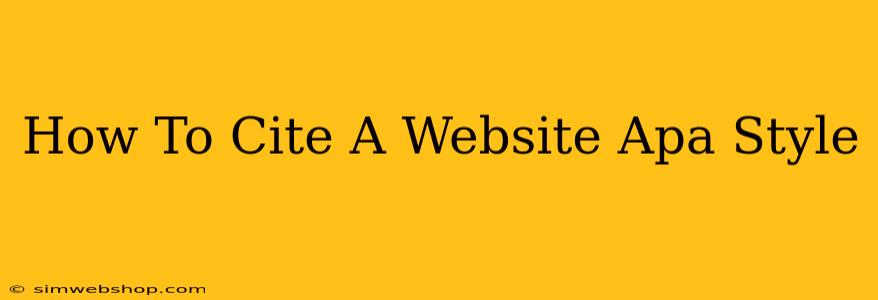Citing websites correctly in APA style can seem daunting, but with a clear understanding of the format and key elements, it becomes straightforward. This guide will walk you through the process, providing examples and tips to ensure accuracy and avoid plagiarism. Proper citation is crucial for academic integrity and allows your readers to easily verify your sources.
Understanding the Basics of APA Website Citations
The core of an APA website citation involves providing enough information for your reader to locate the source. This includes the author, publication date, website title, retrieval date, and URL. However, the specifics can vary depending on what information is available. Let's break it down:
Key Elements of an APA Website Citation:
- Author: If available, use the author's last name and initials. If no author is listed, start with the website title.
- Date: Use the publication date if available. If not, use the "n.d." (no date) abbreviation. Be as precise as possible (e.g., month, day, year).
- Title of the Web Page: Capitalize the first letter of each important word.
- Title of the Website (if different): If the web page is part of a larger website, include the website title in italics.
- URL: Provide the full URL of the specific web page.
- Retrieval Date: This is the date you accessed the webpage.
Different Scenarios and Examples
The information available on different websites varies, influencing the citation format. Here are examples for common scenarios:
1. Website with an Author and Publication Date:
Example:
Smith, J. (2023, October 26). The impact of social media on mental health. Psychology Today. https://www.psychologytoday.com/us/blog/the-mysteries-love/202310/the-impact-of-social-media-on-mental-health
2. Website with an Author but No Publication Date:
Example:
Jones, A. (n.d.). Understanding climate change. National Geographic. https://www.nationalgeographic.com/environment/article/climate-change
3. Website with No Author:
Example:
Understanding the human brain. (n.d.). BrainFacts.org. https://www.brainfacts.org/
4. Website with a Corporate Author:
Example:
American Psychological Association. (2020). Publication manual of the American Psychological Association (7th ed.). https://www.apastyle.org/manual/style-guide.pdf
Formatting Your Citations: Key Considerations
-
Hanging Indent: Use a hanging indent for all your references. This means the first line is flush left, and subsequent lines are indented. Most word processing programs offer an automatic hanging indent feature.
-
Italics: Use italics for titles of websites and longer works.
-
Accuracy: Double-check all URLs and dates for accuracy to avoid errors.
Beyond the Basics: Handling Specific Situations
There are scenarios that require additional consideration:
-
Articles within Websites: If citing an article found within a larger website, treat the article as the main source. Include the website information as part of the retrieval information if necessary.
-
PDF Documents: If you’re citing a PDF document found on a website, treat it as you would any other document, but add the URL to access the PDF.
Mastering APA Website Citations
Consistent and accurate citation is a cornerstone of academic writing. By following these guidelines and adapting them to the specifics of your source, you'll be well-equipped to correctly cite websites in your APA style papers. Remember to always consult the most up-to-date edition of the Publication Manual of the American Psychological Association for the most comprehensive guidance. If you're unsure, seeking help from your institution's writing center or librarian is always a good idea.

